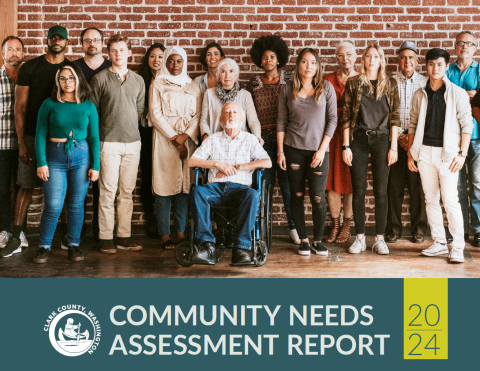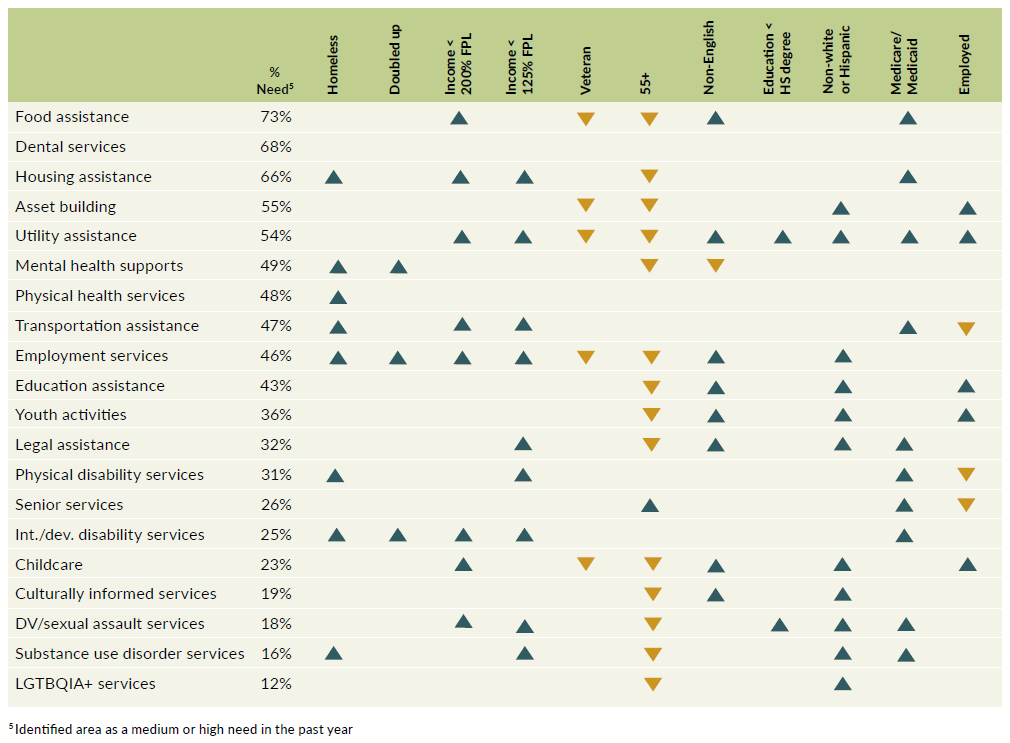Community Action Agencies (CAA), created through Lyndon Johnson’s War on Poverty, serve nearly every community throughout the United States. Over 1,000 agencies provide the opportunity to live in decency and dignity. To determine which services each CAA should be providing in their community, the Community Services Block Grant Act, under Section 676(b)(11) requires the CAA to conduct a Community Needs Assessment (CNA) every three years.
The purpose of the CNA is to:
- Collect and analyze data about the needs of our community that have low incomes
- Inform future funding decisions
- Inform policy and program decisions
2024 Community Needs Assessment
Each time Clark County undergoes the needs assessment process, we look to enhance the process and results of the previous process. For the 2024 Clark County Community Needs Assessment, staff enlisted the help of Community Action Advisory Board members and local stakeholders to provide feedback and expertise through each step of the needs assessment process.
Step 1: Survey of Needs
Clark County conducts an in-depth survey of households who identify as having a low income. All information is strictly confidential and optional. The survey was available in hard copy and online. Hard copy surveys were available in English, Spanish, Russian, Vietnamese and Chuukese (link to each one). Online surveys were available in English, Spanish, Russian, Vietnamese.
Surveys were distributed through partnerships with over 100 community partners, through social media, news releases, local newspaper articles and distributed at several community meetings. Responses to the survey were collected from February 2, 2023, through April 14, 2023. A total of 893 responses were received.
The survey covers several different areas of service and asks what the households top needs are in each category.
Areas of Need:
- Employment
- Education
- Housing
- Income and Asset Building
- Physical Health
- Behavioral Health
- Support Services
Survey respondents are also presented with a list of various areas of need and asked to rank their family’s need in the past year as high, medium, low, or not a need. This information gives a high-level overview of the needs in the community and helps identify trend data.
The next component of the survey is collecting demographic information. This information is completely optional and helps us better understand the households in need.
The final section of the survey is an opportunity for respondents to provide additional comments and sign up for participating in forums and/or interviews to be used in the final assessment. Four community forums were conducted in January 2024. The forums were structured to elicit feedback
on the survey findings, generate discussion on unaddressed needs, and gather suggestions for community improvements.
2024 Community Needs Assessment Appendices
Step 2: Consultant Review
All data from the surveys is sent to an independent consultant that has experience with conducting full community needs assessments. The consultant looks for bias within the responses and trends among the data. The consultant designs the charts that are used showing survey responses throughout the report. One of our favorites is the Population Needs Comparison chart, located on page 38 of the full CNA.
This chart looks at the responses of specific groups of respondents and compares them to everyone else who responded to the survey. An up arrow indicates that group of people have a higher need for the service than everyone else. A down arrow indicates a lower need and no arrow means there is no discernible difference of that group when compared to everyone else. For example, respondents who identified as being 55 years of age or older indicated they had a higher need for senior services than all other respondents, but a lower need for services such as childcare, education and youth activities.
Step 3: Community Feedback
Once all survey responses were collected and the data reviewed by our consultant, we conducted community feedback forums. Three in-person forums and one online forum were held. Forums were interactive using online polls and small group discussions. The forum included a brief presentation on the reason for the forum and a data walk through the survey responses.
Step 4: Other Report Review
Throughout the needs assessment process, CNA Task Force members and staff collected reports from other agencies about our community. Some provided data that was used to identify the causes and conditions of poverty in Clark County. Some reports provided supporting information about the needs identified by survey respondents.
Step 5: Community Needs Assessment Adoption
The final step of the process was to take all the information gleaned from the survey responses, community forums and review of other reports and create the Clark County Community Needs Assessment. A different consultant was used for the initial drafting of the assessment and a cohort of county staff and the CNA Task Force reviewed and updated the report to get to the final version. Once all parties provided feedback, the final version was provided to the Community Action Advisory Board for adoption.
Once the final draft was adopted, the report was sent for translation to ensure the report is accessible in all the languages the original Survey of Needs was provided. A news release was completed, and the final report was sent to all the partners who helped with the needs assessment process, anyone who expressed interest in having a copy of the report when completing the Survey of Needs, to elected officials and local funders of social services.
If you would like a printed copy of the report, please contact Abby Molloy. We will do our best to get you a copy. Please include your name, address and which language you prefer.
How to get involved
If you are interested in helping with the next needs assessment process, please let us know. We want to make sure that everyone has a chance to identify the needs their household has so we can direct funding to the most appropriate and needed services. Please contact Abby Molloy if you would be interested in:
- Distributing surveys to people who are low income.
- Participating in focus groups and/or community forums to provide feedback on survey results.
Special Thanks to the Community Needs Assessment Task Force!
This integral team worked with staff over an 18-month period to develop every component of the CNA process from reviewing the Survey of Needs, creating the Community Forum in a virtual format and reviewing the final draft. The CNA Task Force reviewed, provided feedback and reviewed information again throughout the process, making sure to incorporate an equity lens so that all the components were more accessible to low-income community members. The CNA Task Force included Community Action Advisory Board Members Amy Roark and Melanie Green; community advocates Esra Khalil with the Community Foundation for Southwest Washington, Laura Ellsworth with Council for the Homeless, Morgan Gist with Recovery Café; community partners Lauren Hendrickson with Clark County Public Health and Liz Kearny with Clark County Community Services; and community members Cherise Billington and Rickiesha Hinchen.
For more information, contact Abby Molloy, 564.397.7832.

